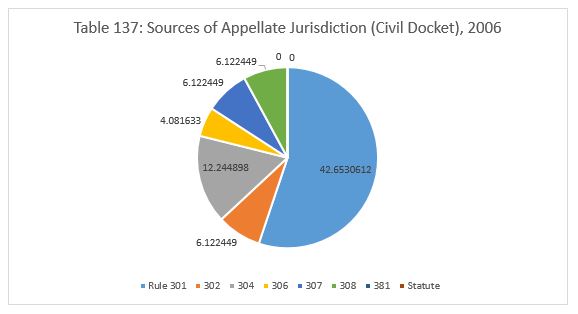Last week, we began the latest phase of our analysis of the decision making of the Illinois Supreme Court by looking at the question of whether the Court prefers to review final decisions from the trial courts rather than interlocutory orders. [1] We found that during the years 2000-2004, appeals brought under Supreme Court Rule 301 – which authorizes appeals from final judgments of the Circuit Courts – tended to run around sixty percent of the Court’s civil docket. We now turn to the Court’s civil docket between 2005 and 2009.
In Table 136, we report the data on the Court’s civil docket for 2005, with each source of jurisdiction measured as a percentage of the whole. Appeals from final judgments increased somewhat from 61% in 2004 to two-thirds (32 cases) in 2005. Appeals under Rule 302 dropped slightly from 2004 to 2005. Rule 306 appeals – interlocutory appeals by permission – dropped by about one third, and appeals under Rules 304, 306 and 308 were remained at about the same level in 2005 as they were in 2004.
In Table 137 below, we report the data for the civil docket in 2006. Appeals from final judgments were sharply down as a fraction of the entire docket, as were Rule 302 appeals. On the other hand, appeals pursuant to Rules 304 (“final” judgments disposing of less than all parties) and 307 (interlocutory appeals as of right) were sharply up. Rule 306 appeals were down in 2006 by one third as a fraction of the civil docket. Appeals under Rule 308 (certified questions) remained at almost exactly the same level of the civil docket as they were in 2004.
Table 138 below reports the data for the civil docket in 2007. Appeals from final judgments pursuant to Rule 301 returned to the level they were in 2005. Rule 302 appeals were up by fifty percent in 2007. Appeals under Rules 304 and 308 were static as a fraction of the Court’s civil docket, but the Court heard no cases at all in 2007 pursuant to Rules 306 or 307.
Appeals pursuant to Rule 301 drifted even higher in 2008 (30 cases), as shown in Table 139. Appeals under Rule 302 and 308 were sharply down, although Rule 304 appeals were up by one third as a fraction of the total civil docket.
In Table 140 below, we report the data for 2009. The fraction of the docket accounted for by Rule 301 moved even higher, topping out at 73.8% of the Court’s civil docket. Appeals pursuant to Rule 302 were 4.8% of the Court’s docket – double the level one year earlier. On the other hand, Rule 304 appeals were sharply down.
Join us tomorrow as we compare the data for the civil docket to the numbers for the criminal docket between 2005 and 2009.
Image courtesy of Flickr by John Morgan (no changes).
———————————————————————
[1] While we were expanding the data library to encompass all of the Court’s decisions, we revisited the opinions we had previously assigned to the civil side of the docket. Ultimately, on further consideration, we reassigned just below two percent of the collection from criminal to civil or vice versa. Accordingly, the data we report on the civil side will not precisely match in all cases the numbers we discussed last spring.





